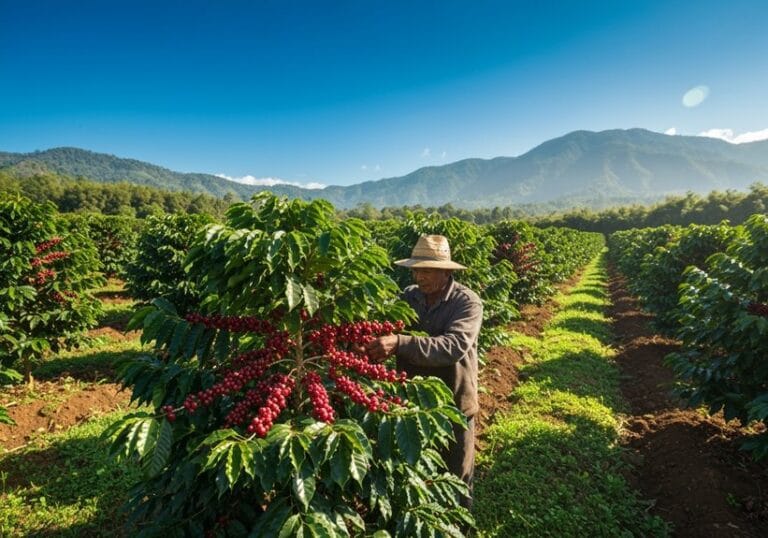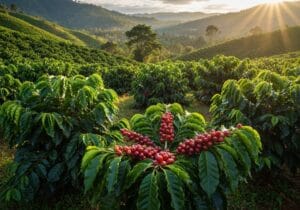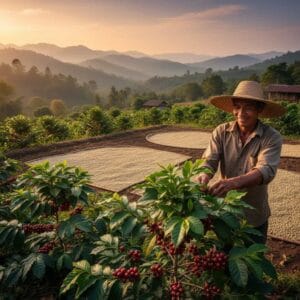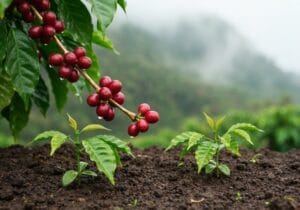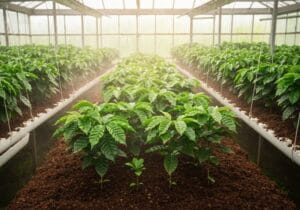A coffee plantation is like a fancy backyard where coffee literally grows—seriously! Found in the “Coffee Belt” near the equator, these plantations can be cute little family farms or big commercial operations (think coffee kingdom!). They grow different types of coffee beans—Arabica for smooth sipping and Robusta for those who prefer a strong kick. The plants need care, like rich soil and good weather, and the way they’re harvested can totally affect flavor (who knew?!). Stay tuned for more coffee fun!
Key Takeaways
- Coffee plantations are dedicated agricultural estates where coffee plants are cultivated, primarily in the Coffee Belt region between the Tropic of Cancer and Capricorn.
- There are different types of coffee beans, mainly Arabica and Robusta, each with distinct flavors and characteristics based on cultivation and propagation methods.
- Ideal cultivation conditions include rich, well-drained soil with a slightly acidic pH, along with a climate that avoids extremes of temperature.
- Harvesting methods significantly impact coffee quality, with selective picking ensuring ripe cherries, while strip picking increases yield but may lower quality.
- Successful coffee production relies on careful management of environmental factors, harvesting practices, and the economic landscape of specialty markets.
Definition and Location of Coffee Plantations
Coffee plantations, those sprawling lands where caffeine dreams come to life, are much more than just fields of green. They’re grand agricultural estates dedicated to coffee growing, ranging from tiny family farms to massive commercial setups, each with a unique story to tell.
Picture those perfectly lined rows, 1,200 to 1,800 plants per hectare, waiting patiently for their caffeine-filled glory. Most coffee crops don’t produce until three or four years in—talk about the ultimate waiting game! Additionally, many plantations adopt shade-grown practices that enhance biodiversity and promote ecological benefits.
And let’s not forget the ideal conditions—they sit mainly in that magical “Coffee Belt” between the Tropic of Cancer and Capricorn. Imagine sipping a robust brew while knowing it came from a sun-soaked paradise or a cozy mountain nook—yup, that’s coffee plantation life for you!
Types of Coffee and Propagation Methods
In the world of coffee, it’s not just about the brew, it’s about the beans! You’ve got your main players: Arabica, Robusta, Liberica, and Excelsa—each with their own quirks.
Arabica’s like the smooth-talking romantic, while Robusta is the sporty, high-energy type! Then there’s Liberica, the unpredictable artist, and Excelsa, the hipster of the coffee world (so unique, it’s hard to find!).
Now, to grow these marvelous beans, vary your propagation methods! You can start with seed propagation (easy-peasy), cuttings (that’s like cloning your favorite plant), or even tissue culture (the science nerd move!).
Each method affects the coffee production process and those oh-so-important coffee processing steps. Who knew coffee could be this exciting?
Cultivation Conditions and Practices
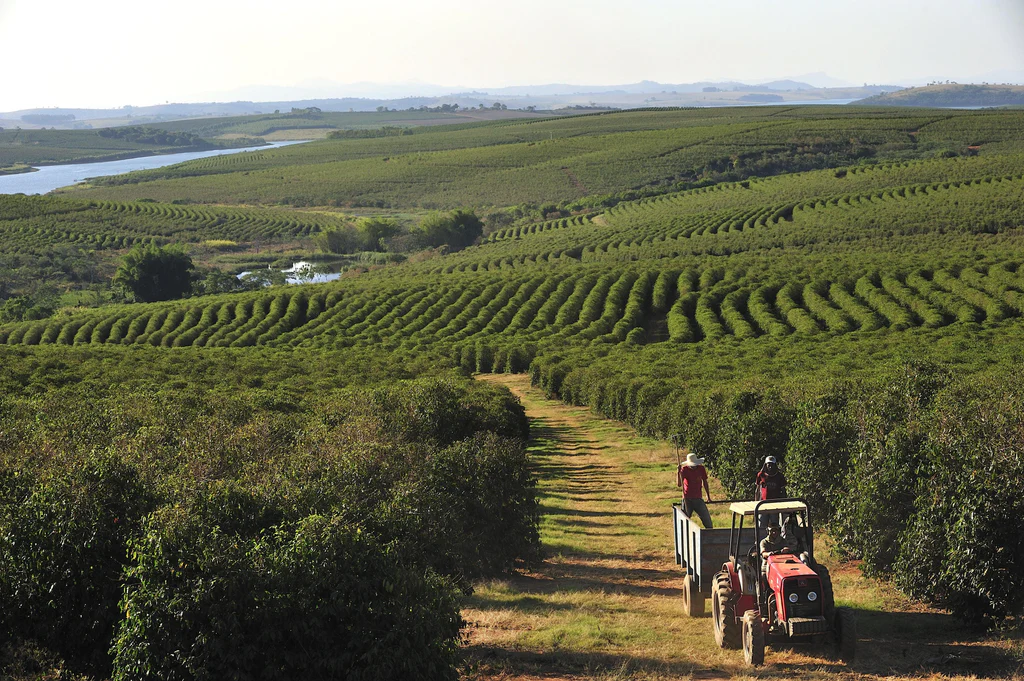
In regard to cultivating coffee, the right conditions and care can make all the difference—like trying to grow a plant in a basement versus a sunny garden, right?
It all starts with soil requirements and preparation; you want that soil rich, well-drained, and slightly acidic. Seriously, a pH of 6.0 to 6.5 is the magic number!
Next, you’ve got to reflect on climate and environmental conditions—think of coffee’s Goldilocks zone, not too hot, not too cold.
And don’t forget planting practices and seedling management—those little guys need TLC, like a cozy nursery for babies!
Ultimately, maintenance and nutrient management are like daily vitamins for your coffee plants; keep the weeds away, feed them right, and you’ll have a thriving plantation! Additionally, incorporating pre-planting organic compost not only enriches the soil but also enhances the plants’ overall health before they are established.
Harvesting and Economic Impact
After all that hard work tending to coffee plants, a likewise essential phase comes into play—harvesting! Yes, folks, it’s time to get your hands dirty!
There are different harvesting methods in coffee plantations, like selective picking—where skilled hands choose only the ripest cherries—or the more chaotic strip picking that pulls everything in sight. Talk about a coffee free-for-all!
Mechanical harvesting can haul in millions of cherries but, hmm, that might mean some unripe ones sneak in too. This impacts quality—and the economic impact on labor and production can’t be ignored.
Hand-picking demands more labor and costs, but specialty markets love those perfect beans! So, whether clumsily handling coffee or expertly sorting, it’s all about the flavor game!
Frequently Asked Questions
How Do Climatic Changes Affect Coffee Plantation Productivity?
Climatic changes considerably reduce coffee plantation productivity by altering temperature ranges, disrupting rainfall patterns, and increasing pests and diseases. These factors diminish yields, raise production costs, and threaten the financial stability of coffee farmers.
What Are Common Pests and Diseases in Coffee Plantations?
Common pests in coffee plantations include the Coffee Berry Borer, Leaf Miner, and Mealybugs. Diseases such as Cercospora Fruit Spot and Sooty Mold threaten plant health, necessitating effective management strategies to preserve yield and quality.
How Is Sustainability Promoted on Coffee Plantations?
Sustainability on coffee plantations is promoted through agroforestry, organic farming, water conservation, and certification schemes. These practices improve biodiversity, soil health, and crop quality while supporting farmer livelihoods and adapting to environmental challenges.
What Role Does Technology Play in Coffee Cultivation?
Technology greatly improves coffee cultivation through precision planting, soil management, mechanization, and digital monitoring, ensuring ideal growth conditions, efficient resource use, improved plant health, and increased yields, ultimately fostering sustainable agricultural practices in the coffee industry.
How Do Coffee Plantations Impact Local Communities Economically?
Coffee plantations substantially influence local communities economically by providing direct employment, invigorating local businesses, and generating income through exports. They often improve infrastructure and social services while fostering sustainable practices, although price fluctuations pose ongoing challenges.
References
- https://www.treeplantation.com/coffee-trees.html
- https://kidskonnect.com/geography/coffee-plantation/
- https://library.fiveable.me/key-terms/ap-hug/coffee-plantations
- https://www.cirad.fr/en/our-activities-our-impact/tropical-value-chains/coffee/plant-and-uses
- https://www.britannica.com/topic/coffee-production
- https://gardeningsolutions.ifas.ufl.edu/plants/trees-and-shrubs/shrubs/coffee/
- https://www.aboutcoffee.org/origins/coffee-regions-of-the-world/
- https://www.nescafe.com/gb/coffee-culture/knowledge/coffee-bean-types
- https://methodicalcoffee.com/blogs/coffee-culture/4-types-of-coffee-beans-what-makes-them-different

